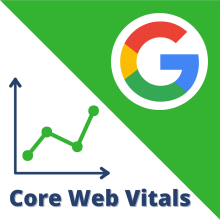
This article contains an overview of Core Web Vitals (CWV). Though CWV is a rather technical topic, we’ve summarized the concepts in an easy-to-understand format.
What Are Core Web Vitals?
Core Web Vitals are a newer feature added to Google’s search and user experience profile in 2020. This set of metrics includes factors that measure loading time and any shifts occurring in your website layout. Core Web Vitals’ primary focus is to provide a user experience analysis of your website with the critical purpose of driving improved user experience across your website.
Where Can I Find CWV Web Data?
The data reported about your Core Web Vitals is real-world data gathered from users running the Chrome Web browser. You can find this data in the Chrome User Experience Report (CRUX).
The CRUX report gathers these performance metrics about how a visitor uses your site, how the website layout shifts, and how long it takes to load. This data collection automatically occurs without alerting or alarming the user. Not all website visitors share data, and not all visits are recorded. However, we can assume that Google will pull as much data as possible from user behavior to produce valid metrics.
Why Is Google Making This Change?
Ultimately, this data collection aims to help people receive better search results, and Google achieves this by understanding which websites are best going to serve their users’ needs. The Core Web Vitals are the next step towards quantifying which websites are doing a better job of providing a great user experience.
As part of this new initiative, Google has announced that they will roll out CWV changes in May 2021. These updates include incorporating more of these user and page experience signals and combining the Core Web Vitals as part of the searching ranking algorithms.
Relevant user experience signals include factors like:
- Mobile-Friendliness
- Safe Browsing
- HTTPS Security
The implementation of Core Web Vitals is exciting because before now, quantifying user experience metrics has been a challenging process. Understanding and analyzing website users behavior has largely been a subjective process. With CWVs, we can better understand and improve user experience with the help of real-world data from actual website visitors and their onsite behavior.
Specific Core Web Vitals Metrics
There are three primary metrics that are tracked and analyzed by Core Web Vitals. They are as follows:
Largest Contentful Paint (LCP)
LCP is the time it takes for the web page’s main content to load. An ideal content paint would be around 2.5 seconds or faster, and this is how fast this web page actually appears on your screen.
We've all probably been to a website where you just sit there waiting for the screen to load. Most of the time, you're probably going to hit that back button or close out the screen if it takes much longer than five or ten seconds. This is a huge factor in overall user experience. If your website's not loading and not producing something on the screen, a site visitor will be more likely to leave.
First Input Delay (FID)
FID is the time it takes for a page to become interactive. When a user is on a web page and finally loads, this metric gauges how long it takes before that user can click on interactive buttons or links that are able to register and actively load the next page.
Ideally, you’ll want this metric to be less than 100 milliseconds, which is super fast and a speed you probably wouldn't be able to notice with the human eye. You might notice a little bit, but these tools inside of Chrome and other web browsers allow you to measure this much more precisely. This way, you can kind of determine how well your web pages are performing.
Cumulative Layout Shift (CLS)
CLS relates to the unexpected shift in layout of visual page content. You’ve probably encountered this kind of website behavior countless times over the years, most typically on mobile devices.
A common CLS experience you may identify with is when you’re reading something online and the text disappears or moves. You may find that you’ve been navigated elsewhere on the page, or you may find an ad overlaying where you were just reading.
Page shifts similar to the example above often result in poor user experience. And though you may have a valid reason why these shifts happen within your website, the impact of WCVs may lead you to further assess the pros and cons and the impact it will have on your SEO.
What is going to happen to those websites that don’t improve their Core Web Vitals?
As part of the May 2021 core update, Google will start taking into consideration these three metrics as part of search ranking algorithms.
Websites with low scores will likely see a negative change in their SEO rankings. Though we will still be able to visit these pages, it may diminish the likelihood of finding them via search engines.
Using Google Tools to Evaluate Your Core Web Vitals
The easiest way to evaluate your website’s Web Core Vitals is through Google Search Console and Pagespeed Insights. Here, you can see reports and determine if you should take action to improve specific areas of your website.
Navigate to the lefthand menu in Google Search Console. Underneath Enhancements, click on Core Web Vitals. The data will be broken into two different device types: Mobile and Desktop.
If you do not have enough user history or traffic for such one of the devices, it will simply inform you there isn’t enough data. For example, your mobile report may not have sufficient data, while your desktop report may have collected enough data to produce a report.
Google will analyze your website by the three CWV metrics: LCP (largest contentful paint), FID (first input delay), and CLS (Cumulative Layout Shift). You'll be able to find a report by navigating to Core Web Vitals in the left-hand menu in GSC, which will show you which of your site's URLs Google analyzes as Poor, Needs Improvement, or Good.
Within each report, GSC will give you a rundown of which URLs are affected in each group, along with some details about which metrics need work. You can also export these reports for offline or in-depth analysis.
